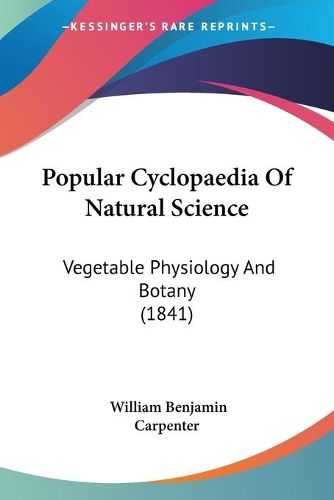Readings Newsletter
Become a Readings Member to make your shopping experience even easier.
Sign in or sign up for free!
You’re not far away from qualifying for FREE standard shipping within Australia
You’ve qualified for FREE standard shipping within Australia
The cart is loading…






Purchase of this book includes free trial access to www.million-books.com where you can read more than a million books for free. This is an OCR edition with typos. Excerpt from book: CHAPTER III. OF TUB ELEMENTARY STRUCTURE OF PLANTS. 66. When we examine yet more closely into the conformation of the different parts of which an organized structure is composed, we find that, though the several organs are variously constructed, and are adapted for different offices or functions, they are built up, as it were, of the same materials. With the same bricks, stones, mortar, and timbers, a church, a palace, or a prison may be reared. Just so is it in organized structures. We do not find that each organ is entirely different from the rest, though it has usually something peculiar to it; but we are enabled to separate it into many distinct portions, something similar to which, if not exactly correspondent, may be recognized in other parts. Thus, for example, it was formerly stated that the leaf consists of a midrib and veins proceeding from it, a fleshy substance filling up the interstices, and a cuticle or skin covering the whole. Now the midrib and vei s, as well as the footstalk of which these are a prolongation, consist of three kinds of structure;?woody fibre, to which they owe their toughness, and by which they are adapted to give support to the softer structures;?ducts or canals for the transmission of fluid;?and spiral vessels which are designed to convey air. On tracing these to the stem, it will be found that they all exist in it under the same form, and that these portions of the leaves are in reality but continuations of it. Again, if we examine the fleshy substance which lies amongst them, we shall find that it corresponds very closely in character with the pulp of soft fruits, or the pith of the stem. And if we strip off the cuticle and investigate its structure, we shall perceive that it is but PRIMARY TISSUES OF PLANTS. 55 another form of the …
$9.00 standard shipping within Australia
FREE standard shipping within Australia for orders over $100.00
Express & International shipping calculated at checkout
Purchase of this book includes free trial access to www.million-books.com where you can read more than a million books for free. This is an OCR edition with typos. Excerpt from book: CHAPTER III. OF TUB ELEMENTARY STRUCTURE OF PLANTS. 66. When we examine yet more closely into the conformation of the different parts of which an organized structure is composed, we find that, though the several organs are variously constructed, and are adapted for different offices or functions, they are built up, as it were, of the same materials. With the same bricks, stones, mortar, and timbers, a church, a palace, or a prison may be reared. Just so is it in organized structures. We do not find that each organ is entirely different from the rest, though it has usually something peculiar to it; but we are enabled to separate it into many distinct portions, something similar to which, if not exactly correspondent, may be recognized in other parts. Thus, for example, it was formerly stated that the leaf consists of a midrib and veins proceeding from it, a fleshy substance filling up the interstices, and a cuticle or skin covering the whole. Now the midrib and vei s, as well as the footstalk of which these are a prolongation, consist of three kinds of structure;?woody fibre, to which they owe their toughness, and by which they are adapted to give support to the softer structures;?ducts or canals for the transmission of fluid;?and spiral vessels which are designed to convey air. On tracing these to the stem, it will be found that they all exist in it under the same form, and that these portions of the leaves are in reality but continuations of it. Again, if we examine the fleshy substance which lies amongst them, we shall find that it corresponds very closely in character with the pulp of soft fruits, or the pith of the stem. And if we strip off the cuticle and investigate its structure, we shall perceive that it is but PRIMARY TISSUES OF PLANTS. 55 another form of the …